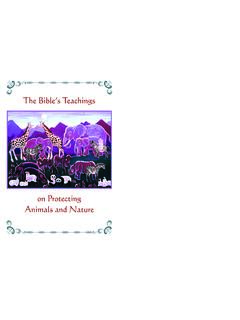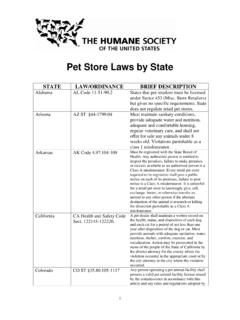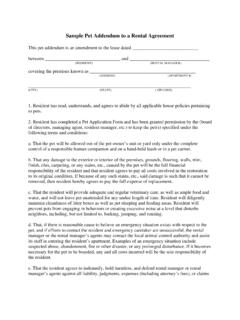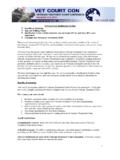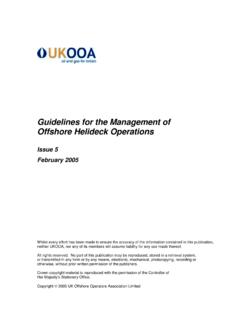Transcription of Solving Problems with Canada Geese - humanesociety.org
1 Solving Problems with Canada Geese A Management plan and Information Problems WITH Canada Geese : A MANAGEMENT plan AND INFORMATION GUIDE1 The HistoryOnce, Canada Geese on a neighborhood pond were unusual. Now, Canada Geese are considered a nuisance in many communities. How did this happen?Decimated by hunting and habitat loss, the giant Canada goose (Branta Canadensis maxima) rebounded after wildlife managers found wild and captive flocks in the 1960s. They bred birds in captivity and relocated them throughout the Geese aren t strong migrants.
2 Captive-bred Geese settled year-round in cities and suburbs where expansive lawns, parks, golf courses, and artificial ponds made perfect goose resident flocks expanded, and by the mid-1980s, researchers were studying the new phenomenon of too many Geese . Conflicts reached a point where the same state and federal agencies that had propagated Canada Geese called for killing Humane Society of the United States (HSUS) objects to killing wild animals simply because they are regarded as nuisances. And killing will not solve the problem.
3 The HSUS has helped many communities resolve human-goose conflicts with more humane and effective approaches. This guide offers a road map of these best practices for living with Canada BY ISTOCKPHOTOPHOTO BY GERRYGRUGIN/ISTOCKPHOTOSOLVING Problems WITH Canada Geese : A MANAGEMENT plan AND INFORMATION GUIDE2 About Canada Geese Canada Geese are grazers and prefer grass, especially fertilized lawn grass. They tend to forage in areas with open sight lines and access to water where they can see and escape Geese pair off in late winter and defend preferred nesting sites those near water with a good view of the surrounding area from other Geese .
4 Geese strongly prefer to nest on islands and peninsulas and tend to use the same nest site year after year. They will also sometimes nest in less than ideal places, such as landscaped areas in parking lots, planters next to busy building entrances, or flat parents defend the nest and goslings until the young are 10 weeks old and can fly. Within a day or two of hatching, parents may lead goslings as far as two miles to grass and water if their nest site does not offer these. In any interaction with Canada Geese , do no harm to Geese , goslings, eggs, or even nests except as permitted by the Canada Geese molt (completely replace flight feathers) each summer and cannot fly during this six-week period.
5 After adults have completed the molt and young Geese grow their first flight feathers, they begin to travel in flocks. Resident Canada Geese usually move only short distances for the winter, but bad weather can cause them to move hundreds of miles in search of open water and law protects Canada Geese . It is illegal to harm Geese , their eggs, or their nests in the United States without permission from the Fish and Wild Service (USFWS). Geese may be harassed or scared away without a permit as long as the Geese , goslings, eggs, and nests are not harmed.
6 USFWS allows resident Canada goose eggs to be treated to prevent hatching after simply registering online (details below).About the ConflictsGeese graze on lawns. And where Geese graze, they also defecate, raising the ire of people who use these areas. Sometimes, people express concerns about health and safety as well. Research has not found any significant health threats from goose feces. However, people want to avoid contact with any animal feces and abundant deposits on playing fields and in high traffic areas make that difficult.
7 In some places, Geese may cross roads or forage near roadsides, creating a potential traffic Geese and parents of goslings protect their young. Approach a nest or family of goslings and you will provoke defensive reactions but rarely be attacked. When people are injured, it nearly always results from a startled person falling down rather than from direct contact with a BY JIM PFIELSOLVING Problems WITH Canada Geese : A MANAGEMENT plan AND INFORMATION GUIDE3 You Need a plan To design an effective plan : Examine how, when, and why Geese are using the site.
8 Select the best combination and timing of techniques to make your site less attractive to Geese . Develop a plan of how you will apply these techniques at your site. Implement your plan . Monitor how it works, adjusting where needed. The goal is to reduce the nuisance to an acceptable level. It is not possible, even if it were desirable, to eliminate Geese from a community. So, solutions need to address the specific conflicts and the sites on which they are occurring not attack all Geese is no single quick fix that will resolve human-goose conflicts at every site.
9 But well-designed integrated programs can resolve , an organization dedicated to building better communities through innovative, effective, and humane solutions to wildlife conflicts, has developed an effective template that communities can adopt. This can greatly simplify your planning. See Sources of Additional Information, below, for Effective plans get synergy from combining two or three Key Components curtailing reproduction, site aversion (harassing or scaring the Geese to teach them the site is not safe), and habitat Key Components Curtailing Reproduction Site Aversion Habitat ModificationCurtaining reproduction combined with strong, effective, well-timed site aversion is the crux of most successful programs.
10 When adult Geese are not tied to flightless goslings after the nesting season, these adults can be harassed away from preferred foraging sites before summer brings large numbers of people to those sites. And clearing open spaces of goose concentrations with their attendant droppings prior to the mid-summer molt eliminates the most significant , modifying habitat makes site aversion, especially with trained dogs (more below), more effective by making Geese feel less secure from BY KATHY MILANI/THE HSUSSOLVING Problems WITH Canada Geese : A MANAGEMENT plan AND INFORMATION GUIDE4 Effective goose management programs typically follow a seasonal timeline: December to March.





